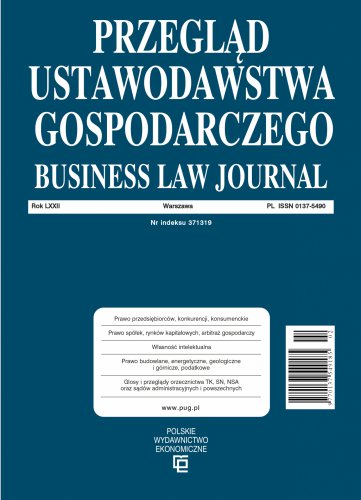Artificial intelligence in mediation in civil and commercial cases
The purpose of this article is to present selected legal issues concerning the possibility of using artificial intelligence in mediation processes in business cases. The article opens with brief remarks succinctly outlining the genesis of the concept of artificial intelligence and the different approaches to it on the grounds of various scientific disciplines. The advantages and drawbacks of using artificial intelligence in the role of a mediator and as a tool used by a mediator in mediation proceedings are also discussed. The author also presents the potential dangers of using artificial intelligence in mediation proceedings from the perspective of the principles governing it, emphasizing the importance of interpersonal relations and communication (verbal and non-verbal) between the parties in the course of mediation.
References
Andraško, J., Mesarčík, M., & Hamuľák, O. (2021). The regulatory intersections between artificial intelligence, data protection and cyber security: Challenges and opportunities for the EU legal framework. AI & Society, 36, s. 623–636, https://doi.org/10.1007/s00146-020-01125-5
Bellman, R. E. (1978). An Introduction to Artificial Intelligence: Can Computers Think? Beyond and Fraser Publishing Company.
Bieda, R. (red.). (2021). Analiza wybranych aspektów projektu aktu w sprawie sztucznej inteligencji. Fundacja AI Law Tech.
Butterworth, M. (2018). The ICO and artificial intelligence: The role of fairness in the GDPR framework. Computer Law & Security Review, 34(2), 257–268. https://doi.org/10.1016/j.clsr.2018.01.004
Čerka, P., Grigiene., J., & Sirbikyte., G. (2017). Is it possible to grant legal personality to artificial intelligence software systems? Computer Law & Security Review, 33(5), https://doi.org/10.1016/j.clsr.2017.03.022
Cybulko, A. (2028). W: E. Gmurzyńska, & R. Morek (red.), Mediacja. Teoria i praktyka. Wolters Kluwer.
Dynarski, K., & Przybył, M. (2020). Pismo Święte Starego i Nowego Testamentu (wyd. 5). Pallottinum.
Flaga-Gieruszyńska, K. (2019). Zastosowanie sztucznej inteligencji w pozasądowym rozwiązywaniu sporów cywilnych. Studia Prawnicze KUL, (3), 91–102.
Gmurzyńska, E., & Morek R. (red.) (2018). Mediacje. Teoria i praktyka. Wolters Kluwer.
Gregg, E. M., Koch, B., & Smith, D. W. (2019). How artificial intelligence is impacting litigators. ALAS Loss Prevention Journal, (Summer), 48–59.
Hancock, J. T., Naaman, M., & Levy, K. (2020). AI-mediated communication: Definition, research agenda, and ethical considerations. Journal of Computer-Mediated Communication, 25, 89–100. https://doi.org/1093/jcmc/zmz022
Haugeland, J. (1989). Artificial Intelligence: The Very Idea. MIT Press.
Hawkins, J., & Blakeslee, S. (2005). Istota inteligencji (T. Walczak, tłum.). Onepress.
Jakubecki, A., & Telenga, P. (2017). Kodeks postępowania cywilnego. Tom I. Komentarz do art. 1–729. Wolters Kluwer.
Kaczmarek, D. (2017). Mediacja obligatoryjna w świetle orzecznictwa Trybunału Sprawiedliwości Unii Europejskiej. Studia Administracyjne (9), 137–153.
Katz, D. M., Bommarito II, M. J., & Blackman, J. (2016). Predicting the behavior of the Supreme Court of the United States: A general approach. PLoS ONE, 12(4), https://doi.org/10.1371/journal.pone.0174698
Kingston, J. (2017). Using artificial intelligence to support compliance with the general data protection regulation. Artificial Intelligence and Law, 25, 429 – 443. https://doi.org/10.1007/s10506-017-9206-9
Krasuski, A. (2020). Status prawny sztucznego agenta. Prawne podstawy zastosowania sztucznej inteligencji. C.H.Beck.
Kuner, Ch., Cate, F. H., Lynskey, O., Millard, Ch., Ni, L. N., & Svantesson D. J. B. (2018). Expanding the artificial intelligence-data protection debate, International Data Privacy Law, 8(4), 289–292, s. 289–292. https://doi.org/10.1093/idpl/ipy024
Kyotoprize.org. (b.d.). John McCarthy. https://www.kyotoprize.org/en/laureates/john_mccarthy/
Magnusson Sjöberg, C. M. (2020). The digital person-a new legal entity? On the role of law in an AI-based society, perspectives in law, business and innovation. W: M. C. Compagnucci, N. Forgó, T. Kono, S. Teramoto, & E. P. M. Vermeu (2020). Legal Tech and the New Sharing Economy (81–91), Springer. https://doi.org/10.1007/978-981-15-1350-3
Mazurek, G., & Małagocka, K. (2019). Perception of privacy and data protection in the context of the development of artificial intelligence. Journal of Management Analytics, 6(4), 344–364. https://doi.org/10.1080/23270012.2019.1671243
McCarthy, J. (2007, listopad). What is artificial intelligence? Computer Science Department, Stanford University. https://wwwformal.stanford.edu/jmc/ (pobrano 25.09.2023).
Morgan, M., Broman, M., & Finckenberg-Broman, P. (2017). Human-Robotics & AI interaction: The Robotics/AI legal entity (RAiLE©). IEEE International Symposium on Technology and Society (ISTAS).
Motrou, L. (2018). Data protection, artificial intelligence and cognitive services: Is the General Data Protection Regulation (GDPR) 'artificial intelligence-proof'? SSRN eLibrary. http://dx.doi.org/10.2139/ssrn.3386914
Nęcki, Z. (2000). Komunikacja międzyludzka. Antykwa.
Norvig, P. (2016). Artificial Intelligence: A Modern Approach. Pearson Education.
Papakonstantinou, V., & De Hert, P. (2018). Structuring modern life running on software. Recognizing (some) computer programs as new "digital persons". Computer Law & Security Review, 34,(4), 732–738. https://doi.org/10.1016/j.clsr.2018.05.032
Rabinovich-Einy, O., & Katsh, E. (2012). Technology and the future of dispute system design. Harvard Negotiation Law Review, 17, 151–199. https://ssrn.com/abstract=3504126
Reese, H. (2020). AI can predict outcome of human rights trials, but should it? https://www.techrepublic.com/article/ai-can-predict-outcomeof-human-rights-trials-but-should-it/
Russell, S., & Norvig, P. (2022). Artificial Intelligence: A Modern Approach. Pearson.
Samoili, S., Cobo, M. L., Gómez, E., De Prato, E., Plumed, G., Plumed, M., Blagoj, F., & Blagoy, D. (2020). AI watch. Defining Artificial Intelligence. Towards an operational definition and taxonomy of artificial intelligence. Technical report. Joint Research Centre, European Union.
Schuett, J. (2019). A legal definition of AI. Goethe University Frankfurt. https://www.researchgate.net/profile/Jonas-Schuett/publication/336198524_A_Legal_Definition_of_AI/links/5e20599a458515ba208b9e4c/A-Legal-Definition-of-AI.pdf
Szewczyk, R., Huś, T., Starczewska-Krzysztoszek, M., & Ponikowska, M. (red.). (2018). Założenia do strategii AI w Polsce. Ministerstwo Cyfryzacji.
Telenga, P. (2017). W: A. Jakubecki (red.), Kodeks postępowania cywilnego, Tom I. Komentarz do art. 1–729. Wolters Kluwer.
Turing, A. M. (1950). Computing Machinery and Intelligence. Mind, 49, 433–460.
UK Information Commissioner's Office. (2017). Big data, artificial intelligence, machine learning and data protection. https://ico.org.uk/media/for-organisations/documents/2013559/big-data-ai-ml-and-data-protection.pdf
Waszkiewicz, P. (2018). W: E. Gmurzyńska, & R. Morek (red.), Mediacje. Teoria i praktyka. Wolters Kluwer.
Weiser, B. (2023). Here's what happens when your lawyer uses ChatGPT. The New York Times. https://www.nytimes.com/2023/05/27/nyregion/avianca-airline-lawsuit-chatgpt.html
Weiser, B., & Schweber, N. (2023). The ChatGPT lawyer explains himself. The New York Times. https://www.nytimes.com/2023/06/08/nyregion/lawyer-chatgpt-sanctions.html

